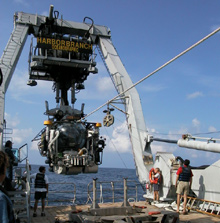
Crew members and researchers test launch-and-recovery procedures for the Johnson-Sea-Link II manned submersible. Click image for larger view.
Mission Plan: Life on the Edge
Exploring Deep Ocean Habitats
Steve W. Ross, PhD
Kenneth J. Sulak, PhD
Elizabeth Baird
Martha S. Nizinski, PhD
Principal Investigators
Background
In comparison to the continental shelves of the United States and the Gulf of Mexico, the habitats of the continental slope, and even the shelf edge, are poorly studied, and, in many cases, completely unknown. These deeper areas, between 100 to 1000 m, are important frontiers, offering a transition from the continental shelf to the true deep sea. Between North Carolina and Florida are several unique and productive deep-water habitats that can only be adequately sampled with nonconventional methods (i.e., manned submersibles) because the bottom topography is extremely rugged and/or the habitats are overlain by extreme currents. It is these largely unstudied habitats that we will target for exploration. Two major complex habitats will be explored: the outer shelf hard grounds (80-250 m) and the middle slope coral (Lophelia) banks.
Outer Shelf 'Live' Bottoms
Hard or "live" bottoms along the U.S. southeast continental shelf include valuable fish and invertebrate resources. This fauna represents an important, productive intrusion of a subtropical community into an otherwise temperate latitude. These habitats are of particular interest because they support high biodiversity, they foster economically important fishes and shellfishes, and they are used extensively for recreation. Although life- history information is available for several economically important fish species, smaller members of the reef community have been mostly ignored, and, thus, our view of these communities is incomplete.
It is increasingly critical to locate and map hard bottoms, especially in deep waters, to protect the habitat itself and to provide resource managers with information on habitat availability for reef fishes. Managers of reef fisheries require more complete information on the extent of hard-bottom habitats to assess the carrying capacity of the reef systems and to estimate the population sizes of species threatened by overfishing. Recent proposals to manage reef fish populations by establishing marine reserves or protected areas also require accurate information on hard-bottom locations and sizes, as well as biological data about the inhabitants. The South Atlantic Fishery Management Council has proposed a large marine protected area (MPA) with two boundary options off North Carolina. This MPA also includes a large and apparently productive shipwreck called “the snowy wreck." This wreck has not been identified, is not well known except by a few fishermen, and is not located on previously published maps.
Deep Coral Banks
Along the 400-500 m depth band, starting off central North Carolina, a narrow band of ridges (banks) rise from the plateau, providing the base for the deep-sea coral Lophelia pertusa. These are not the familiar corals of shallow reefs, but are very slow-growing stony corals adapted to life in dark, cold waters. These corals lack light-dependent symbiotic algae. The living branches are white, forming dense thickets on the tops and sides of banks. Underneath, dead branches accumulate in gray mounds several meters deep and hundreds of meters long. The ridges and reef mounds, which may rise as much as 150 m from the open substrate, accelerate bottom currents that are favorable to attached filter-feeding corals, sponges, and other sea creatures. Thus, the growing reef alters the physics of the water column, enhancing the environment for continued coral growth and attracting more sea life.
Lophelia deep-reef habitat may be more important to many western Atlantic species than previously believed. Indeed, some commercially exploited deep-water fishes, such as wreckfish and blackbelly rosefish, congregate around Lophelia habitat. Rosefish landings have increased greatly in recent years, and we observed evidence of fishing activities (e.g., trash, lost gear) during previous dives on some deep coral banks. Several types of crabs are abundant on the Cape Lookout deep reefs, perhaps providing important food sources for predatory fishes. Other invertebrates, including brittle stars, also populate the coral matrix in high numbers. On the barren and featureless plain of the Blake Plateau, Lophelia reefs form underwater oases that provide both shelter and food. Additionally, the coral thickets are surrounded by extensive coral rubble; our preliminary data indicate that this habitat also supports a unique, diverse group of fishes and invertebrates.
No Lophelia reefs lie within established or proposed MPAs on the U.S. East Coast, but if such reefs prove to be important habitat (as we suspect they are), they may be candidates for protection, as are the Oculina coral reefs off northern Florida. Like Oculina coral, Lophelia is fragile, slow-growing, and vulnerable to physical destruction. Lophelia reefs along the upper slope lie in areas of potential cable-laying and oil/gas exploration activities, and they may be subject to damage from fishing gear. MPAs are a viable option for protecting these systems, and the data we are collecting will contribute to that effort.
Scientific Objectives
Our objective is to document the locations and aerial extent of portions of poorly explored deep-reef habitats (80-700 m), especially on a small scale, as well as document the biodiversity of deep-reef fauna by quantifying habitats, species associations, and behaviors. We will address these objectives by continuing our strategy of sampling the entire water column and using a variety of techniques to identify the full spectrum of sea life and the associated hydrography (water conditions) in each study area. We will cruise aboard the NOAA research vessel (R/V) Seward Johnson and will use trawls, the ship's remotely operated vehicle, and the Johnson-Sea-Link II manned submerisble to explore benthic (bottom) habitats. Although emphasis will be placed on sampling bottom habitats and communities, we will also gather data on surface communities (using neuston nets), particularly those in the large brown seaweed known as Sargassum, and in midwater communities (using Tucker trawls). Simultaneous data collection from benthic habitats to surface waters will enable us to hypothesize about the mechanisms that control and differentiate community structures throughout the water column.





















